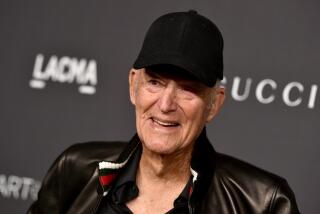Preening the ‘Bird’
- Share via
The design for the “Fire Bird” is Richard Lippold’s, but it is Werner Neblung and his sons Rick and Kevin who must make it fly.
The Neblungs are directing the installation of the huge sculpture at the Performing Arts Center, as they do for all of Lippold’s sculptures. They are involved from the artist’s first sketches through the work’s dedication: they’re the ones responsible for feasibility studies, cost estimates, structural and engineering analyses, fabrication and installation--a process that can take a year or more.
“I was always interested in art and its fabrication, and in sculpting itself,” says the elder Neblung, who runs a large studio in Butler, N. J. “One day Richard (Lippold) came by the shop. He had been referred to me by another artist.”
That meeting led in 1976 to Neblung’s first project for Lippold, the installation of “Adastra” in front of the National Air and Space Museum in Washington. Since then Lippold has worked exclusively with the Neblungs.
The family occasionally works for other artists--including Karl Rosenberg, Robert Adzema and Peter Lobello--and Werner Neblung does some sculpting himself. “Not on Richard’s scale, but I do some large projects.”
But it is their work for Lippold that keeps them busiest, and it is not uncommon for the Neblungs to be working on several of the sculptor’s projects at once. Before coming to Costa Mesa they installed a Lippold sculpture in Crystal City, Va. After installing “Fire Bird,” they hope to take a few weeks’ rest before installing “Orchidia,” Lippold’s 16-story creation for Singapore’s Marina Centre Hotel. After that, the next stop is Korea.
And later this year, the Neblungs will do a structural analysis on what is probably Lippold’s best-known work--”Orpheus and Apollo” in New York’s Avery Fisher Hall. The work is 25 years old, and will be inspected to make sure it’s holding up safely.
But “Fire Bird” is the project at hand. It has been difficult work for several reasons. One complicating factor is the sculpture’s most novel feature--its situation both inside and outside the center’s huge glass wall. Although the sculpture appears to pierce the glass, the inside and outside sections are in fact separate.
“We have to come close enough to the glass to give a sense of continuity, but we have to leave space to allow for movement of the sculpture,” Werner explains. Movement can be caused by wind, earthquakes, or the sculpture’s normal expansion and contraction. There are six inches between the glass and the sculpture.
The sheer size of “Fire Bird”--6,000 pounds, 60 feet tall, 120 feet wide and 100 feet deep--was a challenge. The sculpture’s five sections are supported by 490 cables, 1/8- to -inch in diameter, some as long as 110 feet. Each cable is anchored to a steel plate in the ceiling, placed during construction.
At the time of this interview, just before Labor Day, the Neblungs had been working on the installation of “Fire Bird” for two weeks. They estimate another three weeks of work. “Whenever we do one of these, it’s always the first time,” Rick explains, because every sculpture and its setting are unique. “So we never know how long it’s going to take.”
Lippold himself usually visits a site at the beginning of installation, and returns at the end for a final inspection. Mostly, though, he trusts the Neblungs to get things right without his interference. “We work well together,” Neblung says. “He knows I will do things the way he wants them.”
In a new building such as the center, the installation of a sculptural work is usually the last item on the construction agenda, which has led to some close calls. “We duck out with our toolboxes at one end while people in tuxedos are walking in at the other end,” Werner Neblung jokes.
More to Read
The biggest entertainment stories
Get our big stories about Hollywood, film, television, music, arts, culture and more right in your inbox as soon as they publish.
You may occasionally receive promotional content from the Los Angeles Times.










